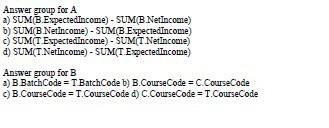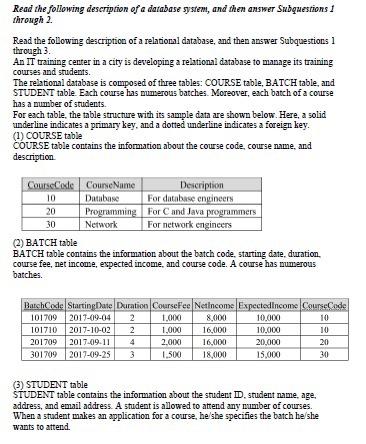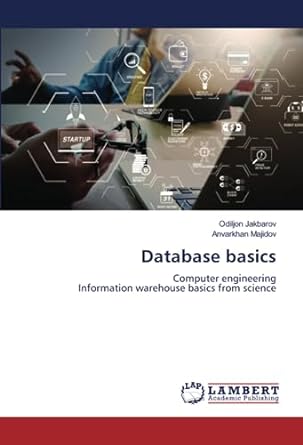
plz see the tables and answer subquestion part .do it fast plzz..need urgent
Read the following description of a database system, and then answer Subquestions: through 2. Read the following description of a relational database, and then answer Subquestions 1 through 3. An IT training center in a city is developing a relational database to manage its training courses and students. The relational database is composed of three tables: COURSE table, BATCH table, and STUDENT table Each course has numerous batches. Moreover, each batch of a course has a number of students. For each table, the table structure with its sample data are shown below. Here, a solid underline indicates a primary key, and a dotted underlne indicates a foreign key. (1) COURSE table COURSE table contains the information about the course code, course name, and description 10 30 CourseCode CourseName Description Database For database engineers 20 Programming For Cand Java programmers Network For network engineers (2) BATCH table BATCH table contains the information about the batch code, starting date, duration course fee, net income, expected income, and course code. A course has numerous batches. BatchCode Starting Date Duration CourseFee Net Income Expected Income Course Code 101709 2017-09-04 2 1.000 8,000 10.000 10 101710 2017-10-02 2 1.000 16,000 10,000 10 201709 2017.09.11 4 2.000 16,000 20,000 20 301709 2017-09-25 3 1.500 18,000 15,000 30 (3) STUDENT table STUDENT table contains the information about the student DD. student name, age. address, and email address. A student is allowed to attend any mumber of courses. When a student makes an application for a course, he/she specifies the batch he/she wants to attend. Student Student Name Age Address Email Address 1 Ms. Alice 20 East 11, Citys aliceat example.com 2 Mr. Bobby 28 North 22, City bobbyla example.com 3 Mr. Charles 24 South 33. City U charles example.com Subquestion 1 From the answer groups below, select the correct answer to be inserted in each blank A in the following SQL statement. In BATCH table the Expectedincome column shows the planned income at the break-even point of profit and loss, and the Netincome column shows the actual income obtained from the batch. Therefore, if NetIncome Expected Income, the batch gains a profit, and if Netincome ExpectedIncome the batch suffers a loss. For the batch that is not completed, the NetIncome column has the value 0. The following SQL statement outputs the course code.course name, and net profit of each course in descending order of net profit SELECT T CouseCode, C.CourseName, T Profit AS NetProfit FROM (SELECT B.CourseCode A AS Profit FROM BATCHB GROUP BY B.CourseCode) T. COURSE C WHERE B ORDER BY NetProfit DESC The SQL statement creates the following output from the sample data of COURSE table and BATCH table shown in the description For example, for course code 10, the batch code 101709 suffers a loss of 2.000, and the batch code 101710 gains a profit of 6.000. Therefore, the course code 10 gains a total profit of 4.000. CourseCode CourseName NetProfit 10 Database 4,000 30 Network 3,000 20 Programming -4.000 Answer group for A a) SUMB.Expected Income) - SUM(B.NetIncome) b) SUMB Netincome) - SUMB.Expected Income) SUMT Expectedincome) - SUMT NetIncome) d) SUM(T.NetIncome) - SUM(T Expected Income) Answer group for B a) B.Batch Code = T Batch Code b) B.Course Code = C Course Code c) B.CourseCode=T.Course Code d) C.Course Code = 1.Course Code


 plz see the tables and answer subquestion part .do it fast plzz..need urgent
plz see the tables and answer subquestion part .do it fast plzz..need urgent 





